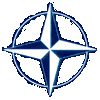 |
|
Canada Allied
|
|
|
| |
|
After 1945, Soviet actions in Eastern Europe and elsewhere created the impression that global Communism was a ruthless, expansionist force. Secret talks on mutual security in 1948 between Canada, the United States, and Britain soon expanded to include other European nations, several of which had already concluded mutual defence arrangements. Having in 1947 committed to European financial aid (the Marshall Plan) and defence assistance (the Truman Doctrine), it was unclear whether Washington would do more. Canadian officials like Hume Wrong and Lester Pearson negotiated to help ensure American participation.
In the end, twelve nations signed the North Atlantic Treaty on 4 April 1949: Belgium, Canada, Denmark, France, Iceland, Italy, Luxembourg, the Netherlands, Norway, Portugal, the United Kingdom, and the United States. They pledged mutual defence, but also - at Canadian insistence - social and economic cooperation. Speaking at the signing ceremony, Pearson, Canada's Secretary of State for External Affairs, noted that Canadians "feel deeply and instinctively" that the treaty is "a pledge for peace and progress". For the first time in its history, Canada had joined a peacetime military alliance.
|
|
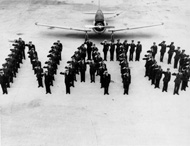
Continuing a tradition of providing flight instruction to its allies begun during the world wars, Canada trained many pilots from European NATO members. In this 1960 photo, aircrew from six allied nations form the alliance's initials. (CWM PL65911)
|
| |
|
Canadians to Europe, Again
|
|
|
| |
|
While the signing of the North Atlantic Treaty did not require immediate military deployments to Europe, Communist aggression in Korea (June 1950) shocked the allies into action. NATO created an integrated military force under the command of American General Dwight D. Eisenhower, the first Supreme Allied Commander in Europe (SACEUR). In November 1951, for the third time in less than forty years, Canadian troops crossed the Atlantic to help defend Western Europe.
Despite welcoming new members Greece, Turkey, and a rearmed West Germany during the 1950s, an outnumbered NATO relied mainly upon nuclear weapons to deter Soviet aggression. The nuclear threat grew progressively less credible with subsequent advances in the Soviet Union's own nuclear capability. In NATO's early years, conventional forces acted merely as a 'trip-wire' to a possible nuclear response but, by the late 1960s, its 'flexible response' strategy envisaged more troops and equipment to fight a conventional war. This option was more expensive, however, and members' spending priorities did not always coincide with perceptions of the Communist threat.
|
|
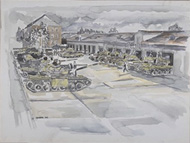
The British-made Centurion tank, acquired in 1951, remained Canada's main battle tank for nearly thirty years. Well-armed, with a powerful Rolls-Royce engine and modern fire control system, the Centurion was one of the best tanks in the world in the early 1950s. Charles Gosbee, Operation Quick-Train - Fort Beausejour (CWM 16738)
|
| |
|
Changing Priorities, Declining Commitments
|
|
|
| |
|
By the late 1960s, for many Canadians the risk of Communist aggression in Europe seemed less immediate than the need for improved social programs and economic and cultural protection against foreign, especially American, influence. The Warsaw Pact's invasion of Czechoslovakia in 1968 reminded Canadians that the Cold War was far from over, but for most of the following ten years détente, or relaxed tensions, marked East-West relations. Canada used the opportunity to reduce its defence budget and armed forces, encourage nuclear and conventional arms control, and reorient its defence priorities to enhance Canadian sovereignty.
A Progressive Conservative government under Brian Mulroney, elected in 1984, attempted in its 1987 defence policy review to strengthen Canada's military, but the collapse of Communist power in Europe halted the effort. After substantial reductions in 1991, in early 1992 Ottawa announced that the last of its ground and air formations in Europe would be coming home.
|
|
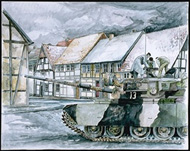
This Canadian Centurion tank crew does routine maintenance during a brief stop in a German village. While relations between NATO troops and German civilians were generally good, it was impossible for NATO's frequent training exercises not to disrupt somewhat civilian traffic, commerce, and ordinary life. Low-level training by NATO aircraft, for example, was a constant annoyance. Charles Gosbee, Preparation (CWM 16736)
|
| |
|
Canada and NATO beyond the Cold War
|
|
|
| |
|
In the 1980s, staunchly conservative governments in several Western countries embarked on military spending programs to counter what they perceived as the Warsaw Pact's growing military advantage. As NATO's capabilities improved, economic problems and social unrest within the Warsaw Pact produced several reformist governments eager to compromise with the West in order to secure stability at home. Mutual arms control agreements and political reforms within the Communist states heralded a wave of democratic upheaval and the end of the Warsaw Pact.
As Canadians welcomed the end of the Cold War in the early 1990s, they also witnessed the transformation of NATO. From a collective defence organization preoccupied with defending its members against external aggression, the alliance assumed broader responsibilities perhaps more accurately described as collective 'security'. With the Soviet military threat ended, NATO supported efforts by the United Nations to secure peace in the Balkans and accepted three former Warsaw Pact adversaries as members of the alliance.
|
|
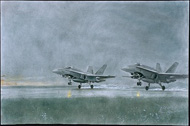
CF-18s take off from a German airfield during a NATO exercise. Bjarni Bjarnason, Hornet Scramble (CWM 85092)
|
